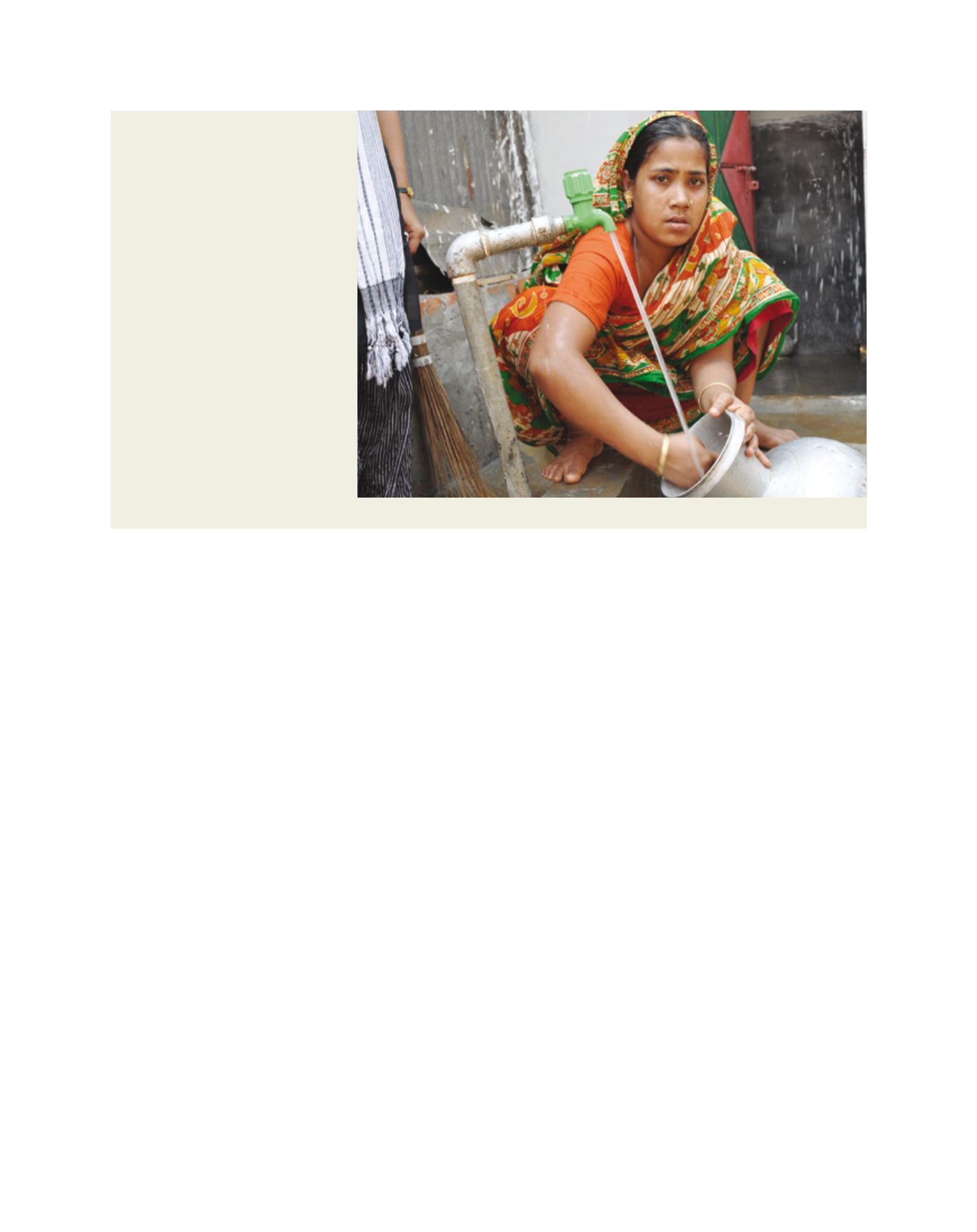

[
] 164
F
inancing
C
ooperation
end of the global water crisis. As a result, low income
households gain access to a microcredit loan to pay for
water connections and toilets within their homes, and
improve the well-being of their families and children.
One size does not fit all
WASH finance is not for everyone. The poorest popu-
lations in most countries, often defined as people
earning less than US$1.25 per day, will continue to
require direct development assistance, such as subsi-
dies to pay connection fees from governments and
other development agencies. Meanwhile, those on the
higher rung of the economic ladder already have access
to traditional streams of financing. A middle portion
of the BOP, however, which we broadly assume to
earn between US$1.25 and US$5.00 per day, can pay
for WASH improvements themselves with the help of
innovative financing that leverages local cash flows and
applies microfinance-styled approaches. In 2008, Meera
Mehta projected a demand of up to US$ 12 billion for
these loans over a decade (2008-2018). If this prom-
ising demand for water and sanitation improvements
continues to go unmet, it will result in market failure
and subsidized aid will not be able to keep pace. By
encouraging promoters and financiers to focus on
this opportunity as a lever, the financial industry can
empower the poor to participate in the global solution
without relying on a failing system.
Through the WaterCredit initiative and other WASH
financing models, organizations can channel and
direct financial resources more efficiently, enabling
a large segment of the population to meet their own
water and sanitation needs through demand-driven,
if they are given the opportunity to do so over time. This might
naturally lead to a thriving market in which those living in the BOP
are empowered to seek WASH improvements – however, access to
financing for water or sanitation improvements (WASH finance)
is rare. While the microfinance sector has made access to finance
more accessible for self-improvement and agricultural loans, this
market has yet to fully reach the water and sanitation sector. With
more than two decades of field experience, research and analysis,
Water.orghas determined that supporting the expansion of WASH
finance for the world’s poor should be prioritized as a major solu-
tion for increasing water cooperation and ending the global water
and sanitation crisis.
WaterCredit is a model premised on the idea that many people in
the developing world can finance their access to safe water and sani-
tation if they can pay for these services over time and have a voice
in their development and operation. In addition, by bringing finan-
cial tools to the WASH sector, WaterCredit can generate economic
opportunities for utilities, governments, suppliers and consumers.
The initiative builds on existing systems of microfinance, the bank-
ability of the poor and the innate desire to improve one’s life and
health. Through WaterCredit,
Water.orgprovides financial and
technical assistance to carefully selected local financial institutions,
including microfinance institutions, to build their capacity to offer
WASH finance to customers at the BOP. These financial products are
designed based on the analysis of local market demand, and allow
capital to be redeployed to finance multiple WASH investments over
time. Philanthropic resources are used to provide the up-front tech-
nical assistance that financial institutions need to develop these new
and innovative loan portfolios. By leveraging philanthropic capital
to reduce risk and initiate loan products rather than using it as loan
capital, philanthropy becomes catalytic and powerful. These funds
can be leveraged for commercial capital to create a demand-driven
and market-based approach which is desperately needed to see the
Success story: Banu
For more than 20 years, Banu has
been living in her Bangladeshi slum of
Begunbari with her two daughters. Her
husband died 15 years ago. She now
works as a housemaid.
Because she did not have a water system
near her home, Banu collected water from
her best option – a dirty pond 20 minutes
away. She had to make this 40 minute
round trip two or three times a day to collect
water for all of her family’s bathing, cleaning
and other household needs.
Today, things are different for Banu
and her daughters. After receiving a
WaterCredit loan from
Water.organd DSK,
a new deep tube well was completed in
her community.
“After the installation of the deep
tube well, we are able to get safe water
much more quickly,” said Banu. “Now I
have enough water for all my household
purposes. Before this well, my daughters
and I would suffer from diarrhoea,
jaundice, dysentery and skin diseases
because of the dirty water from the pond.
By the blessing of God, we don’t have
these water-borne diseases anymore.”
Golbanu Begum cleans vessels at her home’s new water connection in Pallabi, Bangladesh
Image: Water.org


















